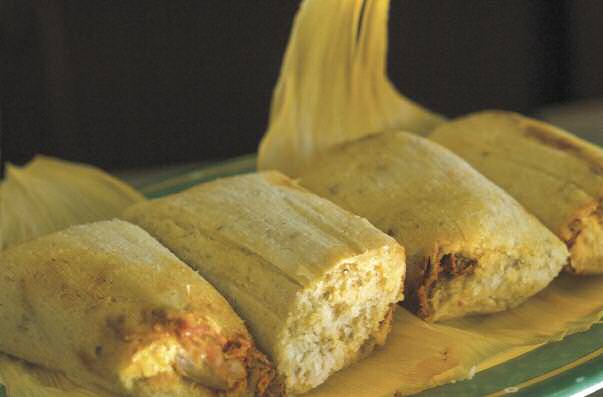TAMALE TRADITION
Savoring the holidays with masa and family.
WRITTEN BY RACHAEL SCALA
PHOTOS BY CANDICE NYANDO
D uring the holiday season, it is not only El Rosal’s tortillas or savory cuisine that draws long lines of customers, but the shop’s masa, or ground corn flour produced from whole kernels. The masa is used in making tamales: a Christmas tradition in many Hispanic homes. In December, families gather in fragrant kitchens to scoop, wrap, tie, steam, and eat or share the bundled delicacies. While some home chefs create their own masa, many appreciate a shortcut to the already labor-intensive process.
|
|
“We boil the corn kernels and then grind it ourselves,” says El Rosal Owner Juan Ibarra of his masa. “There is no masa like this anywhere in the area. And you won’t find preservatives in our product.”
El Rosal has been a top tortilla maker in Reno since 1992. Ibarra produces up to 50,000 tortillas daily for surrounding businesses. They are made from scratch, meaning the corn is cooked, milled, mixed, and pressed in the same location into several types of tortillas, using vegetable oil to create a more wholesome product. The tortillería also boasts a café, and all menu offerings use Ibarra’s family recipes from the Jalisco region (hint: the Adobada, pork in red chili sauce, defines tasty Mexican gastronomy). And during the holidays Ibarra offers the masa to local families readying for the endearing tamale tradition.
REVERED CORN
Tamales are a 5,000-year-old staple in Latino cultures. The tender dumplings originally were produced for Mayan, Aztec, and Inca warriors, wrapped in cornhusks or banana leaves for preservation. Mayans believed their people’s origin to be from corn, and the food staple eventually became a ritual substance in offerings, blessings, and celebrations. Such reverence also has been associated with tamales in both celebration and worship, hence their prevalence during the modern winter holiday season. Each tamale-producing region is known for a special filling, though most people are familiar with chicken and pork tamales served with red or green salsa.
“We put turkey in our tamales around Thanksgiving,” Ibarra says. “But the Christmas season is when each family’s distinct recipe is put to the test and celebrated.”
|
|
The morsels are prepared in large batches, meaning dozens or even hundreds at a time, as the effort would not be worth a smaller yield. This prompts intimate gatherings of friends and family members to share the task. Using the freshest masa is critical, as it yields a softer, more flavorful tamale. It is common for groups of women to spend an entire day executing the steps to complete a batch, each assigned their own duty. The process includes stewing the filling, mixing the masa to dough, rolling out the dough, stuffing the dough, wrapping the dough in cornhusks, and steaming the finished pieces. The rewards can be reaped for months if stored properly, though they are best when freshly made. Few things are more heartfelt than a steaming bundle of tamales, which honor a cherished pastime.
Because of their density and hearty filling, tamales satiate any palate during the winter chill. Try a traditional recipe or mix it up by creating your own filling using winter vegetables. Tamales are great for all meals and are a good start to the day, whether you’re off to work or about to set off on a grueling snowshoe hike. And they’re a perfect contribution to a holiday gathering. Celebrate the richness that this dish adds to the season.
For masa, visit El Rosal Panadería, Tortillería, and Deli at 850 Steneri Way in Sparks. Shop hours are 8 a.m. – 8 p.m. Mon. – Sun. For details, call 775-331-4348.
You can learn to make tamales in a class at Nothing To It on Dec. 13. For details, visit www.Nothingtoit.com.
Rachael Scala is a freelance writer who advocates wholesome, local, and responsibly cultivated foods. Her travel, study, and volunteer experiences have exposed her to many facets of modern food systems. If she’s not out enjoying the Sierra Nevada, you may find her experimenting with her latest batch of kombucha tea.




